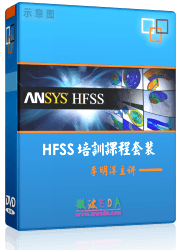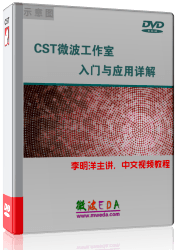Frequency Domain Solver Parameters
 Solver
Solver  Start Simulation Start Simulation  Frequency Domain Solver Frequency Domain Solver
Read the Solver
Overview or the Frequency
Domain Solver Overview to understand the basic concepts of the frequency
domain solver. In this dialog, many important settings for the solver
run can be set. Most of them have a strong influence on the calculation
time. Also, optimization runs and parameter sweeps can be set up from
here.
Solver settings frame
Method: The
Frequency Domain solver offers three complementary methods, each of which
may be used to calculate S-parameters. For the discretization of the geometry,
the hexahedral mesh
as well as the tetrahedral
mesh may be chosen on demand right before the solver start, if the
general purpose solver is used.
However,
for highly resonant structures, the Resonant:
Fast S-Parameter solver is an interesting alternative. This solver
works on hexahedral and tetrahedral meshes and is also available in a
modified form for hexahedral grids, the Resonant:
S-Parameter, fields solver, allowing the calculation of field monitors.
Accuracy:
Defines the desired linear equation system solver accuracy in terms of
the relative residual norm. This is the termination criterion for each
solver run at a single frequency sample. The accuracy is stored separately
for the hexahedral mesh methods and tetrahedral mesh method.
Save all field
results: This button enables you to store all electric and magnetic
fields (E, H) as well as electric and magnetic flux densities (D, B) for
all frequency samples without defining an monitor. To visualize these
fields, select one of the subfolders in Fields
in the result tree folder 2D/3D Results.
See the 2D/3D
Result View for details.
Store result
data in cache: Select this option if you want the solver results
to be stored in the result
data cache. The efficient usage of the result data cache is explained
in the printed documentation "Advanced
Topics".
Calculate modes
only: Enable this check box to calculate the port modes at the
center frequency only.
Excitation settings frame
Please note that exciting a subset of ports
and modes is only available for the general purpose frequency domain solver
with tetrahedral mesh. The general purpose frequency domain solver with
hexahedral mesh can excite single ports only if no waveguide port is present,
i.e., if all ports are discrete ports.
Source type:
In this drop-down list you can select the sources for the frequency domain
calculation, such as waveguide and discrete ports for S-parameter calculations,
or a Plane Wave. The selected
sources will be stimulated. In case of S-parameter ports, this defines
which row of the S-parameter matrix will be calculated. Select All
Ports to calculate the full S-parameter matrix for waveguide and
discrete ports, or All+Floquet
to additionally include Floquet ports. Choosing the List
entry presents a new button offering the possibility to Select...
a special combination of port modes.
Mode:
Shows for which modes the S-parameters will be calculated.
When unit cell boundary conditions are combined
with open boundary conditions in the z-direction, the open boundaries
will be automatically realized by a Floquet port, that allows excitation
of a plane wave. See Boundary
Conditions - Unit Cell and Settings
for Floquet Boundaries for details. The list of ports and modes to
excite then contains the Floquet ports "Zmin" and "Zmax"
as well as the names of the Floquet modes, such as "TE(0,0)"
and "TM(0,0)" for the plane waves.
S-parameter settings frame
Norm to fixed
impedance: S-parameters are always normed to a reference impedance.
You may either select to norm them to the calculated impedance of the
stimulation port or you may specify a number of your choice. Renormalization
to a fixed impedance is only possible if all S-parameters are calculated,
i.e., whenever all ports and modes are excited.
Frequency samples frame
The frequency samples frame is shown for the
"general purpose" methods.
List of samples:
The list of frequency samples allows you to easily define the number,
interval, and sampling method of frequency domain solver simulation points
by entering values in the corresponding columns. Samples may be single
frequencies, distributed equidistantly or with logarithmic spacing, or
automatically chosen frequencies within the given range. When the number
of Samples is not defined (left
blank), the solver stops calculating additional samples as soon as the
S-parameter
sweep convergence criterion is satisfied.
If the upper or lower limit of the frequency
range (columns From and To) is omitted (left blank), the global
frequency range will be used instead. Please note that the global maximum
frequency range is displayed in the first line. To change these values,
you may go into the Frequency
Range Setting dialog box in the main menu under
Settings  Frequency Frequency  . .
Invalid settings will be marked by a red background
color. Right-click in the highlighted cell and select Help
from the context menu to get a hint. Sample definitions (rows of the list)
can be deleted using the context menu, or simply by pressing the delete
key.
For the tetrahedral mesh, the adaptation
frequency can be edited in the sampling list. If chosen automatically,
the adaptation frequency defaults to the upper frequency limit for the
first calculation. The solver may move the automatic mesh adaptation frequency
a couple of times if the input reflection of the S-parameters seems to
be too high. If no suitable mesh adaptation frequency is found automatically,
a constant frequency can be specified instead. Select a type other than
Automatic in that case.
If a broadband
frequency sweep is performed with the stopping criterion enabled
(default, see Frequency
Domain Solver Sampling), the number of frequency samples defines the
maximum number of frequency domain solver runs for a single S-parameter
calculation.
Naturally, the simulation time increases with
the number of frequency samples. This relationship may be approximately
linear. However, if an iterative equation system solver is used, initial
solutions are derived from the data calculated so far, thereby reducing
the additional cost in terms of simulation time.
Use broadband
frequency sweep: Calculate broadband S-parameter curves by using
as few frequency samples as required for reaching the stop criterion defined
in the Frequency
Domain Solver Sampling dialog. In this frequency sweep mode, the number
of frequency samples is an upper limit. At least three samples are required.
Press the Properties...
button to configure the convergence criterion of the broadband S-parameter
sweep.
Resonant solver settings frame
The resonant solver settings frame is shown
for the "fast resonant" methods.
Evaluation
frequency: The "fast resonant" methods yield broadband
S-parameter results. However, one frequency needs to be specified as the
"working point", which is by default placed at the center of
the global frequency range. A different value may be specified here, at
which the reduced order model then is set up and solved. Port modes in
inhomogeneous ports will be calculated at this frequency.
Number of evaluation
samples: The number of samples at which the reduced order model
is evaluated is specified here. Each broadband S-parameter result then
has equidistantly sampled data points according to the number of evaluation
samples.
Adaptive mesh refinement frame
The adaptive mesh refinement settings are stored
separately for the two types of mesh.
Adaptive hexahedral
mesh refinement: Mark this check box to activate the adaptive mesh
refinement for the hexahedral mesh. The mesh will be adaptively optimized
by successively
changing the settings of the mesh expert system. Press the Properties...
button to edit the current settings for the hexahedral
mesh refinement.
Adaptive tetrahedral
mesh refinement: Mark this check box to activate the single frequency
adaptive mesh refinement for the tetrahedral mesh. The mesh will be adaptively
optimized at the adaptation frequency
specified in the List of samples.
Press the Properties... button
to edit the current settings for the tetrahedral
mesh refinement.
Sensitivity analysis frame
Use sensitivity
analysis: Mark this check box to run the sensitivity
analysis. In this case the derivative of all simple parameters are
calculated at the frequency domain solver samples. The results (e.g. derivative
of the S-parameter with respect to a design parameter) can be accessed
via the 1D
Results in the Navigation
Tree. If the broadband frequency
sweep is enabled the sensitivities are interpolated by a rational
fit.
Press the Properties
... button to choose the parameters for sensitivity analysis.
For a more detail description see the sensitivity
analysis page.
Start solver
Calculates the port modes and starts the frequency
domain calculation.
Optimize...
This button opens a dialog box that allows you
to set up and start an optimization
run.
Par. sweep...
Opens the parameter
sweep dialog.
Acceleration...
Opens the acceleration
dialog box to control the high performance options of the simulation
run (e.g. GPU acceleration, Distributed Computing, MPI).
Specials...
This button leads to a dialog
where further special settings for the solver can be made. The settings
are for expert users only and should generally not be changed.
Simplify Model...
Opens the simplify
model dialog.
Apply
Store the specified settings without starting
the calculation.
Close
Closes this dialog box without performing any
further action.
Help
Shows this help text.
See also
Frequency
Domain Solver Overview, Special
Frequency Domain Solver Parameters, Frequency
Domain Solver Sampling, Frequency
Range Setting, Select
Excitation, Distributed
Computing Overview




HFSS视频教程
ADS视频教程
CST视频教程
Ansoft Designer 中文教程
|